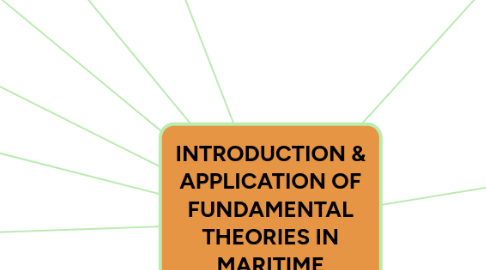
1. IMPORTANCE OF MARITIME INDUSTRY
1.1. Eco Friendly
1.2. Vital for National Security
1.3. Marine/Land Transportation
1.4. Plays a very significant role in the socio economic
2. MARITIME INDUSTRIES
2.1. Shipping & Related Industry
2.2. Fishing Industry
2.3. Tourism Industry
2.4. Petroleum & Gas
2.5. OTHERS AREAS
2.5.1. Food Manufacture
2.5.2. Skills Training Industry
3. PRINCIPAL OCEAN & COASTAL ACTIVITIES
3.1. Navigation & Communication (Shipping)
3.2. Living Marine Resources
3.3. Tourism & Recreation
3.4. Mineral & Energy Resources
4. IMPORTANCE OF THE OCEAN
4.1. Harbour a tremendous wealth of living and non living things
4.1.1. LIVING THINGS
4.1.1.1. Fish (Fisheries Resources)
4.1.1.2. Turtles (Ecotourism)
4.1.1.3. Corals (Diving Ecotourism)
4.1.2. NON LIVING THINGS
4.1.2.1. Bromin (Flame Retardant)
4.1.2.2. Phosporites (Fertilisers & Chemical Products)
4.1.2.3. Sand & Gravel (Constructions - Building)
4.2. Fisheries as source of protein
4.3. A host for many activities
5. OCEAN OF THE WORLD
5.1. Asia
5.2. North America
5.3. South America
5.4. Atlantic
5.5. Africa
6. AREA UNDER NATIONAL JURISDICTION
6.1. Internal waters - Up to 3 nautical miles
6.2. Territorial waters - Up to 12 nautical miles
6.3. Exclusive economic zones - Up to 200 nautical miles
7. DEFINITION
7.1. Connected with the sea, especially in relation to seaborne trade or naval matters.
7.2. Connected with the ocean in relation to navigation, shipping.
8. TYPES OF MARITIME SECTORS
8.1. 1. Fishing Industry
8.1.1. Contribute extensively to the national gross domestic product
8.1.2. Known as a fish consuming country with fish representing 60% of a total animal protein intake
8.2. 2. Petroleum & Gas
8.2.1. Top 10 countries by oil production
8.2.2. In 2017, Malaysia’s LNG & oil exported amounted to RM80 billion
8.3. 3. Communication & Underwater
8.3.1. Existence of seabeed telecommunication cables between peninsula Malaysia and Sabah/Sarawak is an important national asset
8.4. 4. Coastal & Marine Area
8.4.1. Communities are dependant upon healthy ecosystems & habitat which supply plants, animal
8.5. 5. Marine Tourism & Recreation
8.5.1. Ocean & Marine environment has become one of the new fastest growing area Malaysia’s tourism industry
8.6. 6. Ship Building & Repair
8.6.1. Launched by DSN in 2012
8.6.2. In 2020, aims to generate RM6.35 billion in gross national income
8.7. 7. Port Service
8.7.1. Has 7 port as total
8.7.1.1. Port Klang
8.7.1.2. Johor Port
8.7.1.3. PTP
8.7.1.4. Kuantan Port
8.7.1.5. Penang Port
8.7.1.6. Bintulu Port
8.7.1.7. Kemaman Port
9. ISSUES IN MARITIME SECTOR
9.1. Multiple conflicts for the usage area;
9.1.1. Fishing vs Petroleum
9.1.2. Shipping vs Petroleum
9.1.3. Recreational Tourism vs Fisheries
9.2. Oil & Gas affected by the global economy & facing an overcapacity of supply
9.3. Pollution in the marine environment
9.3.1. Example: Oil spills hv sociological impact to the maritime industry
9.4. Climate change
9.4.1. Alters physical, chemical & biological properties of the ocean
10. BLUE ECONOMY
10.1. Concept
10.1.1. Evolved from green movements
10.1.2. Better manage many aspect like (coastal & oceanic, sustainability) ranging from sustainable fisheries to ecosystem health to pollution.
10.2. Blue Economy Sectors
10.2.1. Marine Tourism
10.2.2. Marine Fisheries & Aquaculture
10.2.3. Marine Trade, Shipping & Transport
10.2.4. Maritime Education & Research
10.2.5. Oil, Gas & Minerals

